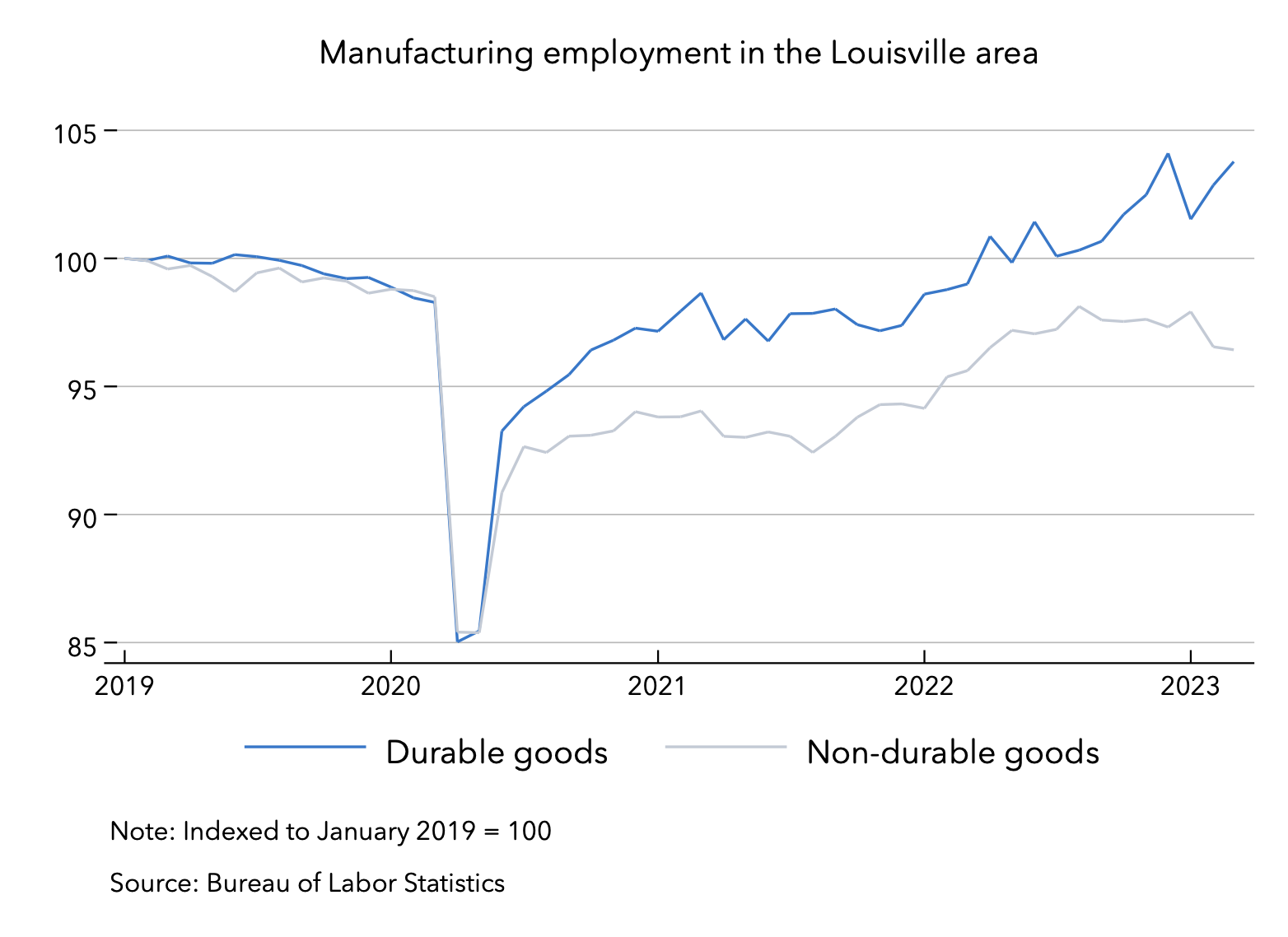Key takeaways
- The Louisville metropolitan area's emphasis on goods-related industries was a boost early in the pandemic.
- Jobs involving non-durable goods are still growing throughout the local supply chain.
- Gaps in staffing for services are expected to persist.
The Louisville metropolitan area includes a diverse group of communities in Kentucky and Indiana where average weekly wages range from $1,295 in Jefferson County down to $795 in Spencer County, right next door. The area's labor market had tracked national averages pretty closely before the Covid-19 pandemic began, but then things changed.
The shift of household spending toward goods that could be consumed at home was a huge boon to the Louisville area, with it strengths in manufacturing, wholesale trade, and logistics. It didn't last forever, though. Now the question is where the growth in the labor market will come from, as well as whether Louisville can capitalize on its earlier momentum.
A boost before the boosters
Early in the pandemic, the unemployment rate in Louisville came down much more quickly than in the country as a whole:

Before the pandemic began, in January 2020, one in four non-farm workers in the Louisville area was involved in manufacturing, wholesale trade, transportation, warehousing, or utilities. At the national level, that ratio was just one in six. So when spending on goods heated up, Louisville sprang into action, with a labor market that was tighter than the national average for a year and a half.
That tightness sent pay rates higher. Between February 2020 and February 2023, average hourly earnings in the Louisville area rose by 21%. Hours also rose during peak periods in 2021 and 2022:

The Bureau of Labor Statistics doesn't provide inflation data for Louisville, but in nearby St. Louis the increase in prices over that period was only 17%. So pay kept ahead of inflation for workers in the Louisville area as they supplied the goods the rest of the nation wanted.
Non-durables' staying power
By the holiday season in 2021, the labor market in the rest of the country had caught up. Then in 2022, demand for durable goods stalled as consumers spent more on services. Employment in those industries never fully recovered in the Louisville area. But jobs producing non-durable goods like food and clothing are still growing steadily:

These kinds of goods still need to be sold and shipped, and so jobs in wholesale trade and logistics are expanding as well:

These industries are pulling in workers at an extremely rapid pace, so it's not surprising that gaps are opening up in other parts of the labor market. Employment in leisure and hospitality, for example, is still well short of its pre-pandemic level:

There are 6% fewer jobs in the sector across the Louisville area than there were before the pandemic, compared with 2% fewer at the national level. This is where staffing needs are likely to be most acute, especially during the high season for sports and events in spring and summer. Businesses are already booking shifts for cooks, servers, and bartenders on our platform; hopefully our growing presence in the area will help more businesses and workers to connect.
These links offer more information:
Bureau of Labor Statistics Economic Summary
Kentucky Center for Statistics
Labor Market Intel (Kentuckiana Works)
Economic Dashboard (Louisville-Jefferson County)
Realtime metrics
These metrics, derived from data aggregated across the Instawork platform, compare the two weeks starting 4/20/2023 to the previous two weeks. To control for the overall growth of the Instawork marketplace, only shifts involving businesses that booked shifts in both periods are included:
- $0.29 rise in hourly pay
- 2.2% point rise in share of short-notice shifts
- 1.9 hours rise in hours per existing worker
To receive future briefings and data insights from our Economic Research team, please subscribe below. Follow Daniel Altman on Twitter at @AltmanEcon or on LinkedIn.








